Australia’s main opposition political party – a coalition of the Liberals and Nationals – has been revived after the two party leaders agreed to reunite.
The latest development comes a week after the break-up of the long-standing coalition of the two conservative parties.
Liberal leader Sussan Ley thanked the Nationals leader David Littleproud for the “respectful and productive way” the two parties had negotiated their reunification – the pair also announced its new shadow cabinet made up of members from both parties.
The Coalition split last Tuesday after Littleproud said both parties were not able to agree on key policy matters but it appears those issues have now been resolved.
“The focus now is on [Australia’s Prime Minister] Anthony Albanese and the Labor government and holding them to account ’cause that’s important for our democracy,” he told media on Wednesday afternoon.
Ley added that the Coalition will be “stronger together, better together and we can’t wait to do this on behalf of the Australian people”.
In announcing the split last week, Littleproud said the Coalition had broken up and reunited in the past, adding that he would work with Ley to “rebuild the relationship to the point we can re-enter a coalition before the next election”.
Ley replaced former Liberal leader Peter Dutton following the Coalition’s poor election results earlier this month, with Labor winning its second term in a landslide victory. She has vowed to bring the Liberals back to the centre-right.
The relationship between the Liberals and Nationals – which mainly represents regional communities and often leans more conservative than the Liberals – had become strained in recent times, with climate and energy being key points of contention.
According to local broadcaster ABC, the two parties have agreed to ditch an earlier commitment to build seven nuclear power plants but will push to lift the national ban on nuclear power.
Other policy positions which have been negotiated as part of the Coalition coming back together include regional infrastructure spending, internet speeds and mobile coverage in regional and rural areas, and improving supermarket competition, the ABC reported.
At Wednesday’s press conference, both leaders refused to be drawn on the issue of net zero commitments – a sticking point within the Coalition – with Ley saying those discussions will happen” inside the policy development process”.
The Coalition reuniting was a “major win” for Ley, according to Mark Kenny, director of the Australian Studies Institute, who told the BBC that the initial break-up was a “dramatic negotiating manoeuvre aimed at gaining greater representation for [Littleproud’s] party”.
Many political observers had expected the Coalition would reunite, Pandanus Petter from the Australian National University’s School of Politics and International Relations told the BBC.
“Neither party can hope to govern without the other,” Mr Petter said, “so maybe [the Nationals] feel they’ve made their point and were able to get some concessions from the Liberals in renegotiation”.
The Liberal-National partnership, which in its current form dates back to the 1940s, has broken down and been re-established several times over the decades.
The last time the Coalition split was almost four decades ago, in 1987.

